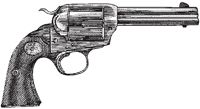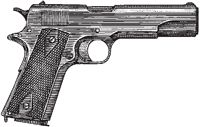American Gun: A History of the U.S. In Ten Firearms (35 page)
Read American Gun: A History of the U.S. In Ten Firearms Online
Authors: Chris Kyle,William Doyle
Tags: #History, #Non-Fiction

BOOK: American Gun: A History of the U.S. In Ten Firearms
10.09Mb size Format: txt, pdf, ePub
Of historical note:
The Spencer was a key development on the road to the modern combat rifle
Trivia:
Following the Civil War, Spencer rifles and carbines were sold overseas to France and Japan. Abe Lincoln tested the Spencer himself before approving its use.
COLT SINGLE-ACTION ARMY

Nicknames & other titles:
Peacemaker, Model P., M1873, Colt .45
First designed by:
William Mason and Charles Brinckerhoff Richards for Colt’s Patent Fire Arms Manufacturing Co.
Type:
Pistol, 6-shot revolver
Predecessor:
Colt Army 1860; there were many other earlier influences
Caliber:
.45 Colt
Variations:
Many, but among the most notable is the Colt Frontier, chambered in .44–40 to be compatible with Winchester 1873 Repeater
When used:
First introduced in 1873, the .45 is still available from Colt
Used by:
Everyone from Teddy Roosevelt to George C. Patton, Pat Garrett to Buffalo Bill Cody
Trivia:
While Colt .45 is the best-known caliber, many revolvers were chambered for other calibers, including the .44-40, so that the ammunition could be used in both the Colt handgun as well as Winchester Model 1873 abd 1892 rifles
WINCHESTER 1873 RIFLE

Nickname:
The Gun that Won the West
Type:
Rifle, lever-action repeater
Predecessor:
Volition Repeating Rifle, Henry Repeater
Caliber:
.44
Historical note:
One of the key members of a family that was the iconic frontier tool for settling the American West
When used:
First introduced in 1873, the gun is still offered for sale by Winchester (although they’re actually manufactured by Miroku in Japan)
Variations:
Among the most important was a carbine version with a shorter barrel and rifles chambered in .38 WCF, .32 WCF, and .22 rimfire. Later Winchester models built on the 1873, even as they added improvements
Trivia:
A musket version with a 30-inch round barrel was among the family’s lesser-known members
TV & movies:
The gun has its own movie:
Winchester ’73,
produced in 1950 and starring James Stewart. Various other Winchesters have been featured in TV and movies; Chuck Connors used a .44–40 Winchester 1892 in the
Rifleman.
SPRINGFIELD MODEL 1903 RIFLE

Nickname:
Springfield
Origin:
The rifle was designed at the Springfield Armory immediately after the Spanish-American War
Type:
Bolt-action rifle
Predecessor:
Mauser bolt-action rifles, 1889–91 & Spanish M93
Caliber:
.30
Notable features:
Bolt-action, five-shot magazine
Cartridge:
The gun fires a .30-06 round. The “aught-six” refers to the year the cartridge was introduced.
When used:
The Springfield 1903 was the standard American Army rifle from its introduction in 1903 until 1936. A large number of Springfields were used in WWII. The weapon is still used for recreation
Trivia:
The cartridge was changed and the gun rechambered after it was discovered that the original cartridge burned too hot. The .30–06 has a slightly shorter case and bullet.
COLT M1911 PISTOL

First designed by:
John Moses Browning
Type:
Pistol, semi-automatic
Predecessor:
The M1911 evolved from a series of designs by Browning in the years before 1911
Caliber:
.45
Notable features:
7-round detachable box; works on recoil principle
When used:
Continuously, from its introduction in 1911 to the present day
Primary users:
Military, police, civilian
Major conflicts involved in:
World War I, World War II, Korea and Vietnam
Trivia:
In WWII, the U.S. military designated the gun “Automatic Pistol, Caliber .45, M1911.” (Current terminology deems the gun a semi-automatic.)
A .22 caliber version was developed as a training aid for the Army.
THOMPSON SUBMACHINE GUN

Nickname:
Tommy Gun, Trench Broom, The Chopper, Chicago Typewriter, The Gun That Made the ’20s Roar
First designed by:
John T. Thompson
Type:
Submachine gun
Predecessor:
While large machine guns predate the Thompson, the weapon defined the submachine gun category when introduced in 1919
Caliber:
.45
Notable features:
Forward grip, drum magazine (interchangeable with stick magazine on most but not all models)
When used:
Developed in 1919, most popular during Prohibition and WWII
Variants:
The first production model was the M1921. Various improvements and refinements continued over the years, especially with the advent of war. The main military variants were the 1928A1 and M1.
Rivals:
The Browning Automatic Rifle or BAR is sometimes cited as a competitor for the title of first submachine gun. But the weight and length of the BAR, along with its selective fire mode, make it more a processor of the assault rifle or, alternatively, what today is commonly called a “squad level machine gun”—a light machine gun that can be carried and operated by one man, such as the FN Minimi.
Trivia:
It is estimated that 1.5 million Thompsons were produced for the U.S. military during WWII
M1 GARAND

First designed by:
John Garand
Type:
rifle, gas-operated, semi-automatic
Predecessor:
The M1 was selected after a competition with another Garand design and a rifle by John D. Pedersen. It was the first truly successful gas-operated semi-automatic infantry rifle in the world
Caliber:
.30–06
Magazine/clip size:
8 bullets
Notable features:
Loads from the top; can be fieldstripped with no tools
When used:
Primarily WWII and Korea. Recreational use continues to the present day. The M1 is also used by some color guards and drill teams.
Countries where used:
U.S., West Germany, Italy, Japan, Denmark, Greece, Turkey, Iran, South Korea
Trivia:
The gun’s inventor was Canadian
.38 SPECIAL POLICE REVOLVER

Other books
Lord of Secrets by Everett, Alyssa
Steel Lily ARC by Megan Curd
Tyranny of Coins (The Judas Chronicles) (Volume 5) Paperback by Aiden James
Song Chaser (Chasers) by Kandi Steiner
Vaseline Buddha by Jung Young Moon
A LIL' LESS LOST (The Kingsmen Book 2) by Oakes, Tara
Children of the Albatross by Anaïs Nin
Impossible Things by Connie Willis
The Housewife Assassin's Relationship Survival Guide by Josie Brown
The Billionaire Saved My Life - PART 2 by Sherie Keys
